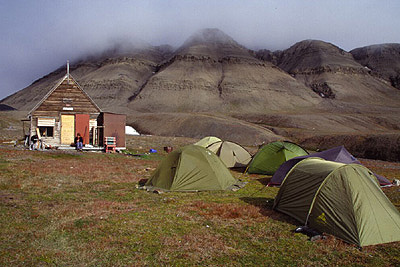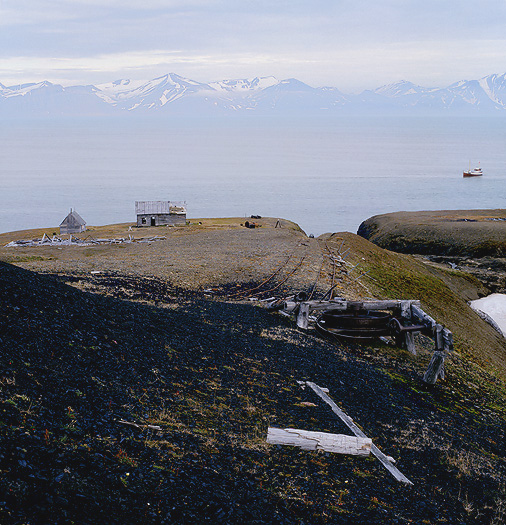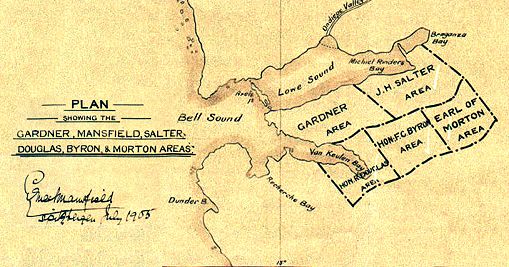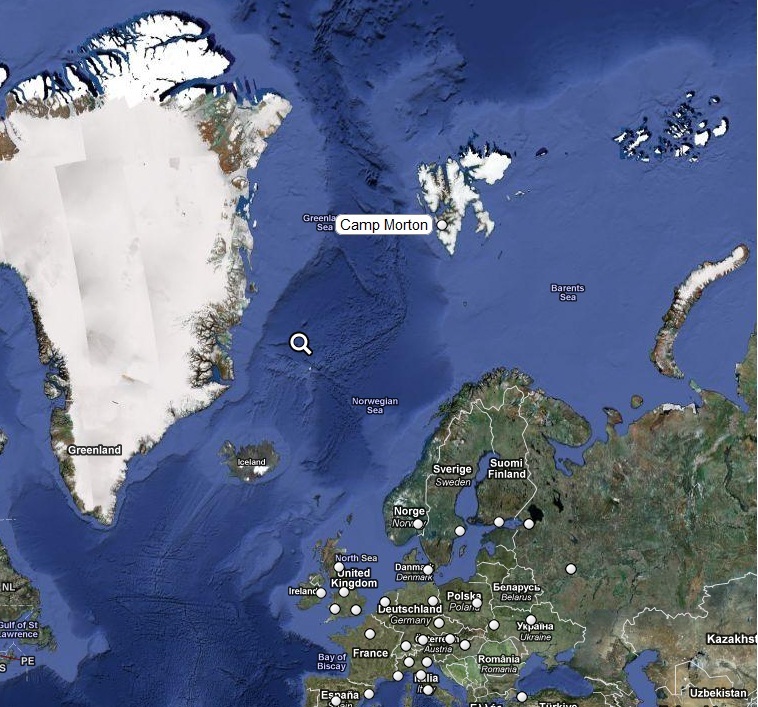Camp Morton, Spitzbergen
Camp Morton was a coal mining encampment on Spitzbergen.

.jpg)



Ernest Richard Mansfield owned a coalmine by Kolfjellet, on the
northern shores of the entrance of Van Mijenfjorden, and erected
some buildings there. The installation was called Camp Morton. The
story goes that before Mansfield’s occupations, the merchant Ivar
Stenehjem got funding in 1901 for a couple of expeditions to
Spitsbergen with the help of ship-owner Christian Michelsen from
Bergen. Michelsen later became Norway’s first prime minister in
1905. At Camp Morton, Stenehjem built a large timber building called
Michelsenhuset, which is still standing today. The same expedition
erected what is now the oldest building in Calypsobyen, west of
Recherchefjorden.
The mines and buildings that Ernest
Mansfield and the Northern Exploration Company Ltd. (NEC)
established in Svalbard were markers to maintain control of their
claims, safeguarding them against competitors that passed through
the area in search of minerals. NEC was originally formed in 1905 as
the Spitzbergen Mining and Exploration Syndicate (SMES), and
re-named in 1910 as the Northern Exploration Company. NEC was formed
by three men from Goldhanger, Essex, Ernest Mansfield, Revd
Frederick Gardner(1) and Dr Henry Salter.
There are many stories and many opinions about the
charismatic leader of the NEC, Ernest Richard Mansfield. He became
legendary in Svalbard during the first decades of the 20th century.
On behalf of the NEC he annexed large areas, especially on the west
coast of Spitsbergen.
Very few people, if any, got as much attention as the founder of Ny-London
during this historical era in Svalbard. To some he was a saint, to
others a swindler. He was very popular amongst his workers and the
overwintering trappers who guarded the installations in winter.
Their stories tell about his benevolence and generosity, and his
ability to make the workers and assistants feel well. The trapper
Henry Rudi said about Mansfield: “During the time we spent with
Mansfield we studied him thoroughly. Was he an explorer? Was he a
swindler? No! Had he been that, we would have revealed it. He was a gentleman and a wonderful person to meet for poor trappers”.
In his short career in the company he established, he occupied
areas from Hornsund in the south to Krossfjorden in the north. All
areas where commercially valuable minerals might be found were of
interest. Sometimes he bought or annexed areas without prospects,
like Camp Smith, with the house Giæverhuset, in Recherchefjorden.
Bellsund was the NEC’s main area for a few years. Camp Morton was
established here to exploit coal, Camp Asbestos was established to
exploit asbestos, Iron Mountain Camp to exploit iron – and so on. In
the north he established Ny-London in Kongsfjorden with the
intention of extracting marble (it crumbled when brought to
warmer climates). Along the west coast of Spitsbergen there are
cabins in various states of repair that were built by, on behalf of
or with funding from Mansfield and the NEC. Some of these were named
after investors and family members: Camp Mansfield, Camp Zoe,
(Mansfield’s daughter), etc., as was Camp Morton.
Mansfield
was the NEC. Despite this, after the “marble fiasco” at
Blomstrandhalvøya, he was removed from the leadership of the company
in 1913. After that he had nothing more to do with the company.
Ernest Mansfield had an artistic mind and lots of charisma. He was a
dreamer with ambitious goals, and a sincere wish for the big
discovery. The dream was shattered, the marble at Blomstrandhalvøya
crumbled in his hands, but the memories of this man and the remains
of his brash endeavours live on in Ny-London and other places on
Svalbard.
William Speirs Bruce founded the Scottish
Spitsbergen Syndicate, a mineral exploration company to locate and
assay the potential of the Svalbard archipelago for the exploitation
of minerals such as coal, gypsum, iron ore, marble and possibly
petroleum. The initial work was to be primarily scientific, but good
commercial prospects were held out as incentives to shareholders in
the company. The Syndicate attracted notable Edinburgh and Glasgow
businessmen, who speculated in the venture, and young Scottish
academics, who found that Svalbard provided an exciting field venue
for their work in geology and surveying. Despite seven expeditions
between 1909 and 1922, no commercial mining operations were
conducted by the Syndicate. By 1920, the Syndicate has filed claims
to mining rights for 7,709 square kilometres, much more than any
other company. To protect these claims, Bruce petitioned the British
government to re-assert British rights to the sovereign control over
the archipelago, but there was little real interest in Whitehall for
such an annexation. Svalbard's position in international law was not
resolved finally until the Spitsbergen Treaty was signed in Paris in
1920, and Norway became the sovereign power in 1925.
Bruce's
collection of specimens, gathered from more than a decade of Arctic
and Antarctic travel, required a permanent home. Bruce himself
needed a base from which the detailed scientific reports of the
Scotia voyage could be prepared for publication. He obtained
premises in Nicolson Street, Edinburgh, in which he established a
laboratory and museum, naming it the Scottish Oceanographical
Laboratory, with the ultimate ambition that it should become the
Scottish National Oceanographic Institute. It was officially opened
by Prince Albert in 1906. The links with Camp Morton have yet to be
made.
The Earl of Morton had several Arctic interests. He and
Alexander Bruce Hugh, 6th Lord Balfour of Burleigh had major shares
in the little known Spitzbergen Coal and Mineral Ltd of London
before Morton became involved in the Spitzbergen Mining and
Exploration Syndicate (SMES) in 1906, although he is not listed as
such in the 1911 & 1913 company share prospectus booklets. His third
son, Hon (Rory) Archibald Roderick Sholto, was also a shareholder in
the latter. Then there were shares in Arctic Ltd (no further details
known).
Sholto George Watson Douglas, 19th Earl of Morton,
and his sons, Rory, Charley, Ronald and William sailed to Norway and Spitzbergen May - July 1906 on the S.Y. Latona. Also on board was
Rev Frederick Gardner, Mrs McPherson, Tom Kendall, Unknowns Mawson,
who left at Tromso, Parry, Hanson, Scaif, Imby, who left the boat at
Hammerfest, and Hewitt. Mawson and Imby were both ill.
One
source reports that Balfour and perhaps The Reverend Frederick
Ernest Charles Byron, 10th Baron Byron (also an original shareholder
in the SMES) were on board. On Spitsbergen and at Camp Morton at the
time were Ernest Mansfield (prospector, Goldhanger, Essex), Rev
Frederick Gardner(1), Charles Mann (Goldhanger,
Essex), George Alexander (Little Totham, Essex), and 13 or 14
Norwegian workers. This report also refers to the yacht, Cressida
R.Y.S., which was photographed(3) off the Morton
estate, Conaglen, on Loch Linnhie in 1911 (and 1916?).
The coal mine at
Camp Morton was being opened up in 1906. Initially open-cast, it
never got particularly deep. An entry in the photgraph album refers
to Spitzberg Coal and Trading Company. It was later taken over by
the Northern Exploration Company, when it appears Frank Wild(4)
was in charge. Work had totally stopped by the mid-1920s.
The following has been contributed by
David
Newman (14 Feb 2013):
In the last two years my (David Newman's) continuing research has
uncovered more details, maps and photographs of the activities
of Ernest Mansfield associated with Camp Morton on Spitzbergen
which is now better know by its Norwegian name of Svalbard.
Perhaps most significantly maps have been identified that
show the original mining claims of the group involved. One map
shows the Spitzbergen Mining and Exploration Syndicate lands
claimed by the Earl of Morton, The Countess of Morton, D Campell
and The Hon E Ponsonby. It also shows Camp Morton and "Axels
Island" close by. This map does not appear to be dated. Another
map, signed by Ernest Mansfield and dated July 1905, shows
similar areas claimed by the Earl of Morton, Hon F C Byron, Hon
R Douglas, Gardner, J H Salter and Mansfield.
Charles
Mann's photograph album remains in the possession of his family
and many of the pictures have annotations in both Charles Mann's
and Ernest Mansfield's handwriting. Some were taken at Camp
Morton and show men working on the buildings, and one shows
Ernest Mansfield inside a cabin with "Camp Morton" on a plaque
above his head.
The main building at Camp Morton,
originally called Michelsenhuset, is still standing and has
recently been restored by the Norwegian cultural heritage
authorities. It is better known today as Camp Morton and is
effectively a listed building. The hut immediately adjacent to
it, previously called "Clara Ville", is also still standing.
This was built by Charles Mann and George Alexander in 1908, and
was named after Charles Mann's relative, his Aunt Clara, with
whom he lived at the time in Goldhanger. The Governor of
Svalbard currently makes this hut available to the Longyearbyen
snowmobile club.
Many photographs of the two cabins at
Camp Morton have been found, some recent, and some from the
past, with several appearing on the internet. Some of these have
allowed me to identify more of Charles Mann's photos as scenes
at the same camp. The older photos have a "Camp Morton" sign
over the door of the smaller Clara Ville cabin. A third large
building also appears in some the older photos, which was
probably a dormitory hut for the many mine workers. More recent
photos show mining relics, including rail tracks, rail wagon
wheels and the remains of small boats.
The Reverend
Frederick Ernest Charles Byron, the10th Baron, whose name also
appears on the claims maps, was rector of Langford in Essex
between 1891 and 1914. The village of Langford is just 3 miles
from Goldhanger where the Revd Gardner was rector in the same
period and they clearly knew each other and the Earl very well.
In 1932 when the Northern Exploration Company was sold in
its entirety to the Norwegian government, 58 huts were included
in the sale, and 27 of those remain standing today. Camp Morton
and Clara Ville are two of the 27.
The Svalbard Museum
has some original "claims plates" with the Earl of Morton and
Lord Balfour of Burleigh's names on them. Images of these are on
the internet.
David Newman is a co-author of a
recently published biography of Ernest Mansfield entitled
"Ernest Mansfield - Gold or I'm a Dutchman" The book contains
many references to Camp Morton and to the Earl. Some of the
photos and one of the maps mentioned above are included in the
book.
The other two authors are Dr. Susan Barr, special advisor in
polar matters with the Directorate of Cultural Heritage, in
Oslo, and Greg Nesteroff, journalist and historian in Nelson,
BC, Canada. The book is published by Akademika in Trondheim,
Norway with sponsorship from the Svalbard Environmental Fund as
there are expectations of sales on Norwegian and other cruise
ships visiting the Svalbard fiords from where the huts and
mining relics can be observed.
Although the book is the
biography of Ernest Mansfield covering his activities in New
Zealand, Australia, Canada, England and Spitsbergen, the book
concentrates on his Spitsbergen activities for which he is most
well known.
The book and it has a surprising 37 references to "Camp Morton"
and "Earl of Morton" within it.
Notes:
1. Rev Frederick
Gardner, parson and prospector, Goldhanger, Essex, thought to be
connected to a wealthy banking family. Private chaplain to the Earl
at Conaglen for 8 weeks in September/October 1899. In the Rector’s
obituary in The Times of 1936 it says… “During the War he joined the
late Lord Morton’s yacht in a mine sweeping expedition operating on
the west coast of Scotland”
2. comment
deleted
3. See the Camp Morton Photo Album
4. Commander John Robert Francis Wild CBE, RNVR,
FRGS (born 10 April 1873 in Skelton-in-Cleveland, North Yorkshire to
19 August 1939 in Klerksdorp, South Africa), known as Frank Wild,
was an explorer on five expeditions to Antarctica for which he was
awarded the Polar Medal with four bars, one of only two men to be so
honoured, the other being Ernest Joyce.
5. SY Latona at the time belonged to Sir John Whitaker Ellis, a
Conservative Party politician in the United Kingdom and Lord
Mayor of London 1881
See also:
Camp Morton Photo Album
Discussion in our
Community Network.
Goldhanger in the Past

Any contributions will be
gratefully accepted
Errors and Omissions
|
|
The Forum
|
|
What's new?
|
|
We are looking for your help to improve the accuracy of The Douglas
Archives.
If you spot errors, or omissions, then
please do let us know
Contributions
Many articles are stubs which would benefit from re-writing.
Can you help?
Copyright
You are not authorized to add this page or any images from this page
to Ancestry.com (or its subsidiaries) or other fee-paying sites
without our express permission and then, if given, only by including
our copyright and a URL link to the web site.
|
|
If you have met a brick wall
with your research, then posting a notice in the Douglas Archives
Forum may be the answer. Or, it may help you find the answer!
You may also be able to help others answer their queries.
Visit the
Douglas Archives Forum.
2 Minute Survey
To provide feedback on the website, please take a couple of
minutes to complete our
survey.
|
|
We try to keep everyone up to date with new entries, via our
What's New section on the
home page.
We also use
the Community
Network to keep researchers abreast of developments in the
Douglas Archives.
Help with costs
Maintaining the three sections of the site has its costs. Any
contribution the defray them is very welcome
Donate
Newsletter
If you would like to receive a very occasional newsletter -
Sign up!
|
|
|
|
|
|
|
|


